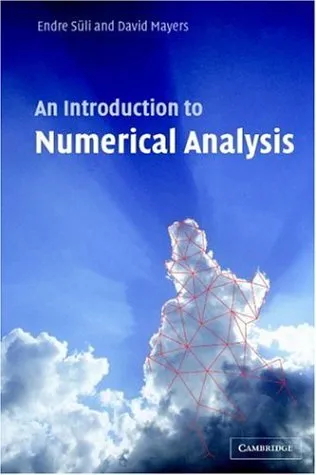An Introduction to Numerical Analysis
4.4
بر اساس نظر کاربران

شما میتونید سوالاتتون در باره کتاب رو از هوش مصنوعیش بعد از ورود بپرسید
هر دانلود یا پرسش از هوش مصنوعی 2 امتیاز لازم دارد، برای بدست آوردن امتیاز رایگان، به صفحه ی راهنمای امتیازات سر بزنید و یک سری کار ارزشمند انجام بدینمعرفی کتاب «An Introduction to Numerical Analysis»
کتاب «An Introduction to Numerical Analysis» توسط نویسندگان Endre Süli و David F. Mayers یکی از برجستهترین منابع در زمینه تحلیل عددی است که به شکلی جامع، شفاف و دقیق مفاهیم کلیدی این حوزه را ارائه میدهد. این کتاب با هدف فراهمکردن درکی عمیق از تحلیل عددی برای دانشجویان و پژوهشگران ریاضی و علوم کاربردی نوشته شده است. در این متن، سعی کردهایم تمامی بخشهای مرتبط با این اثر را شرح دهیم تا علاقهمندان بتوانند از آن بهرهبرداری کنند.
خلاصه جامع کتاب
کتاب «An Introduction to Numerical Analysis» دارای رویکرد آموزشی منظم و گامبهگام است که به مطالعه مفاهیمی همچون تقریب توابع، حل معادلات غیرخطی، حل دستگاههای خطی، درونیابی (Interpolation)، مشتق عددی، انتگرالگیری عددی و حل معادلات دیفرانسیل معمولی میپردازد. تمرکز این کتاب نه تنها بر اثبات ریاضی روشها، بلکه بر تحلیل خطاها و پایداری عددی است. به این ترتیب، خواننده میتواند با اطمینان خاطر از روشهای ارائه شده برای مسائل واقعی استفاده کند.
این اثر دانشجویان را تشویق میکند تا به جای استفاده صرف از الگوریتمهای از پیش تعریفشده، مفاهیم اساسی پشت آنها را درک کنند. زبان دقیق و واضح کتاب نه تنها برای کسانی که در ریاضیات عمیقاً تخصص دارند، بلکه برای افرادی که تازه وارد این حوزه شدهاند نیز مناسب است.
دستاوردهای کلیدی کتاب
از مهمترین ویژگیهای این کتاب میتوان به موارد زیر اشاره کرد:
- بررسی دقیق تکنیکهای پایهای تحلیل عددی و کاربردهای عملی آنها.
- ارائه تمرینهای متنوع همراه با راهحلهای گامبهگام برای فهم بهتر مفاهیم.
- اهمیتدادن به تحلیل دقت و پیچیدگی زمانی روشهای مختلف.
- استفاده از مثالهایی که بر قدرت و ضعف الگوریتمها تأکید دارد.
- توضیح روشهای اساسی مانند Newton’s Method، Gaussian Elimination و Runge-Kutta به زبانی ساده و کاربردی.
این کتاب برای دانشجویان کارشناسی ارشد و دکتری در رشتههای ریاضیات، کامپیوتر و علوم کاربردی بهخوبی طراحی شده است. همچنین، برای حرفهایهایی که به دنبال ایجاد پایه محکم در این زمینه هستند، یکی از گزینههای مناسب محسوب میشود.
جملات معروف از کتاب
"Numerical analysis is not simply the study of the execution of numerical algorithms, but also the analysis of their accuracy and stability."
"A good numerical algorithm is not only reliable and efficient but also robust in handling unexpected problems."
"Understanding the mathematical theory behind numerical methods allows us to design new algorithms and improve the existing ones."
چرا این کتاب اهمیت دارد؟
تحلیل عددی یکی از شاخههای اساسی و محوری در ریاضیات کاربردی به شمار میآید که تأثیر بسزایی در پیشرفت علم و فناوری داشته است. از طراحی نرمافزارهای کامپیوتری تا حل مسائل مهندسی پیچیده، تحلیل عددی بهعنوان ابزاری قدرتمند شناخته میشود.
کتاب «An Introduction to Numerical Analysis» با پوشش عمیق و دقیق موضوعات، نقش مهمی در آموزش این شاخه به علاقهمندان دارد. اهمیت این کتاب نه تنها به دلیل محتوای گسترده و ساختار روشن آن است، بلکه به دلیل تقویت مهارتهای تفکر ریاضی و ارائه دیدگاهی جامع در مورد مسائل عددی است.
استفاده دانشپذیران از این کتاب به آنها توانایی تجزیه و تحلیل مسائل، انتخاب الگوریتم مناسب و در نهایت توسعه روشهای جدیدتر را میدهد. این ویژگیها باعث شدهاند تا این کتاب به یکی از منابع اصلی در حوزه خود تبدیل شود.
An Introduction to Numerical Analysis
Welcome to "An Introduction to Numerical Analysis", a comprehensive guide crafted to present the foundational techniques, principles, and applications of numerical methods. Written by Endre Süli and David F. Mayers, this book is an essential resource for undergraduate and graduate students in mathematical sciences, engineering, and computational disciplines. It combines theoretical rigor, practical problem-solving strategies, and step-by-step algorithms that anchor numerical analysis as an indispensable part of modern scientific inquiry.
Detailed Summary of the Book
The book tackles the core challenges of numerical computation with care, offering a solid foundation in mathematical principles while illustrating their relevance in computational practices. By building a bridge between abstract theoretical analysis and real-world computations, Süli and Mayers emphasize the development of both mathematical rigor and practical understanding.
The text covers a variety of key topics, including polynomial interpolation, numerical integration, approximation techniques, nonlinear equations, iterative methods for solving systems of equations, eigenvalue problems, and more. Each chapter is meticulously structured, beginning with a thorough explanation of the mathematical foundations before moving on to algorithm derivations and practical examples.
What sets this book apart is its balanced approach: it ensures that readers grasp the theory behind numerical methods while also equipping them with the tools to implement these methods effectively. The authors also highlight common pitfalls and errors encountered in numerical computations, teaching readers how to analyze and mitigate such issues.
By the end of the text, readers will have developed an appreciation for the synergy between mathematics and computation and will be well-prepared to tackle complex computational problems in scientific and engineering contexts.
Key Takeaways
- Blend of theory and practice: The book provides a deep understanding of mathematical algorithms and their computational implementations.
- Problem-solving techniques: Learn practical, step-by-step methods for addressing numerical challenges in various fields of study.
- Error analysis: Gain insights into the sources and consequences of errors in numerical computations and strategies for minimizing them.
- Wide range of topics: From interpolation and iteration to eigenvalues and optimization, the book covers an extensive array of fundamental concepts.
- Rigorous yet accessible: The lucid exposition combines depth with an approach tailored for students new to numerical analysis.
Famous Quotes from the Book
"Scientific computing does not replace mathematics; it enhances it. Numerical analysis is the mathematical bridge connecting the abstract to the tangible."
"Approximation is at the heart of numerical analysis. Understanding the limits of approximation helps us master the infinite with finite means."
"Errors are inevitable in numerical computation, but understanding their nature transforms them from obstacles to tools for refinement."
Why This Book Matters
In a world increasingly reliant on computational technology, a robust understanding of numerical analysis is more important than ever. Virtually every field that employs mathematical modeling—from physics and engineering to data science and economics—depends on the techniques and methodologies discussed in this book.
"An Introduction to Numerical Analysis" stands out due to its pedagogical clarity and depth. It empowers readers not only to execute numerical methods but also to understand the underlying mathematical framework, enabling them to innovate and adapt these techniques for new challenges. By fostering both analytical thinking and computational proficiency, the book facilitates the development of a skill set that is as timeless as it is versatile.
This book matters because it demystifies what can often seem like an abstract and inaccessible domain. Whether you're a student seeking to master numerical techniques, an educator looking for a well-structured resource, or a professional striving to deepen your understanding of scientific computing, this text is an invaluable guide. Its enduring relevance is a testament to its authors’ ability to distill complex concepts into a structured and approachable format, making it a cornerstone in the field of numerical analysis.
دانلود رایگان مستقیم
برای دانلود رایگان این کتاب و هزاران کتاب دیگه همین حالا عضو بشین
برای خواندن این کتاب باید نرم افزار PDF Reader را دانلود کنید Foxit Reader


